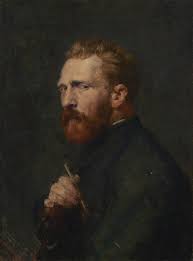
Vincent Willem van Gogh ( 1853 - 1890 )
was a Dutch Post Impressionist painter who is among the most famous and influential figures in the history of Western art. In just over a decade he created about 2,100 artworks, including around 860 oil paintings, most of them in the last two years of his life. They include landscapes, stil lifes, portraits and self-portraits, and are characterised by bold colours and dramatic, impulsive and expressive brushwork that contributed to the foundations of modern art. His suicide at 37 followed years of mental illness and poverty.
In 1880, at the age of 27, he decided to become an artist. He moved around, teaching himself to draw and paint and receiving financial support from Theo. In 1886, Van Gogh joined Theo in Paris, and met many artists including Degas, Toulouse-Lautrec, Pissarro and Gauguin, with whom he became friends. His style changed significantly under the influence of Impressionism, becoming lighter and brighter. He painted a large number of self-portraits in this period.
In 1888, Van Gogh moved to Provence in southern France, where he painted his famous series 'Sunflowers'
Arguably the most influential painter of the 1800s, he set himself apart as a Post-Impressionist artist capable of capturing great beauty and depth of emotion in his many pieces. In looking at a cross section of his work, it is easy to spot a clear evolution from the very anatomically accurate paintings of his early years to the more whimsical creations of his final days. These slow but notable changes in Vincent Van Gogh painting style and techniques make him a very fascinating artist to study. Today, artists continue to make use of Van Gogh’s favored techniques, which include impasto, perspective frame usage and painting from memory.
Due to his impressive command of color, as in all aspects of his painting, his use of color evolved greatly over the course of his career, with earlier pictures including such dark tones as olive and raw sienna. Many of these early paintings featured miserable miners and peasants, and as such, the use of earthly tones was necessary in order to capture the seeming hopelessness of these subjects. This is especially evident in The Potato Eaters,which depicts a family of laborers gathering for a decidedly modest meal.
Impasto
Perhaps best known for his thick use of paint, Vincent Van Gogh was a famous adherent to the popular painting technique known as impasto, which involves the thick laying down of paint on a particular segment of the canvas. This technique makes brushstrokes more visible and, once the paint has dried, adds an extra element of texture. In Van Gogh’s work, the use of impasto had a huge effect on lighting, with the raised, almost three dimensional surfaces of his paintings appearing different depending on the source of light. Perhaps the most notable uses of impasto in Van Gogh’s work can be witnessed in such famous paintings as Starry Night and Wheat Field With Cypresses, both of which would arguably not be nearly as impactful without the texture and emotion attributed to this memorable technique.
Perspective Frame
Many of the world’s greatest artists have struggled with perspective, including, of course, Vincent Van Gogh. The painter was not afraid to admit to the challenges he faced with perspective. He made a good faith effort to improve his technique with the help of various guidebooks, but in the end, he came to rely on a handy perspective frame. Constructed with the help of a local blacksmith, this boxy frame allowed Van Gogh to view the scenes he was painting as if he happened to be looking through a window. The frame also hastened the painting process, allowing Van Gogh to accomplish more in a far shorter period of time. In a letter addressed to younger brother and art dealer Theo Van Gogh, the artist described his use of the perspective frame in detail, even including a sketch of him using the wondrous tool.
Such A Great Artist And Even Greater Was His Art!!
He once said,
" I put my heart and my soul into my work, and have lost my mind in the process. "

ArtVista Born out of genuine interest and passion, artvista developer's interest and awareness in vivid facts of art like paintings, sculptures mural, ceramic art, wall painting, photographs, Art gifts and so on amongst the present art conscious fraternity.
With our focus on long term association and the consequent collaborative actions we believe that we can work together to nurture talented artists and promote Indian Pure art globally. This enables us to work with partners towards positive results and outcome in association with one artist and the relatively of art buyers and collections Art Vista creates a great opportunity for artist to exhibit their works to thousands of viewers-both on-line and off- line.